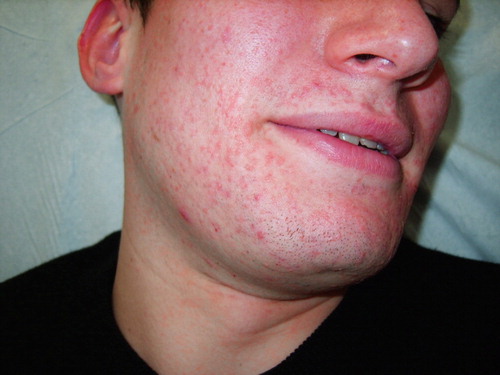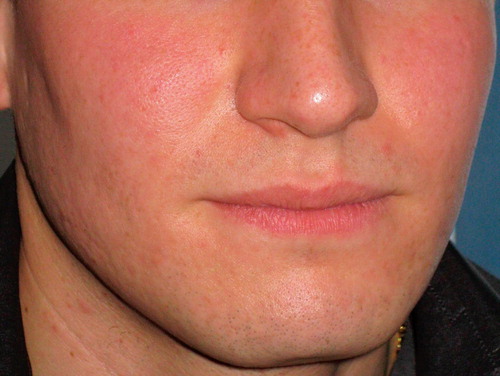Sirs,
The facial flat wart is caused by human papilloma virus and these lesions may be observed on the face, dorsal hands and shins. Although different therapies, such as keratolytic agents, topical immunomodulators and radical measures, have been used for multiple warts of the face, the results may be troublesome (Citation1).
In fact, all these treatments may be painful, not successful and there are numerous relapses. Photodynamic therapy (PDT) with topical photosensitizer application followed by irradiation with red light has been recently proposed for the treatment of viral warts. Side effects of this therapy are few: patients complained of moderate pain or burning sensation, and subsequent scars are usually not observed (Citation2).
We describe one case of multiple facial warts successfully treated with this method.
A 22-year-old man (Fitzpatrick phototype 3) came to our attention for recalcitrant and multiple viral warts of the face lasting 1 year. He presented multiple warts, most of them situated on the beard area (). He had developed few lesions after sun exposure, and subsequently the number of warts had increased.
Figure 1. Flat-topped papules and some acneiform lesions on the beard area before the topical and MAL-PDT treatment.

He did not have a history of immunodeficiency. After a month of the use of 80% trichloroacetic acid and 0.05% isotretinoin solution to reduce the thickness of lesions, we used MAL-PDT: we applied the MAL with occlusive dressing technique for 2 h and then used a red light source (630 nm, 37 j/cm2 – Aktilite® CL128 LED) for 8 min. The lamp-to-skin distance was 5 cm. After the first session, the patient showed a clearance of the 60% of warts. The second session of PDT was performed after a month with the same modalities. After two sessions of PDT, the patient achieved a complete clearance of the warts (). We did not notice any severe reaction or side effect, except transient local erythema. The patient complained only mild burn sensation, moderate pain and some pustules. A biopsy performed 1 month after this treatment did not show any sign of wart.
After a year of follow-up, he did not present recurrences.
The PDT consists in the topical application of the 5-aminolevulinic acid (ALA) or its methyl ester (5-methylaminolevulinic acid or MAL), followed by irradiation with red light: this process results in the creation of free radicals able to destroy diseased tissues (Citation2). PDT is a method usually employed for the treatment of non-melanoma skin tumors, in particular actinic keratosis, superficial basal cell carcinoma and Bowen disease, and some inflammatory dermatoses (Citation3). The use of PDT for facial plane warts has been reported in three studies (Citation1,Citation4,Citation5), but in these studies the photosensitizer was ALA and this drug requires a longer incubation period (3–6 h) (Citation1,Citation5) and a longer time exposure (20 min) (Citation5) to red light. Moreover, just one patient achieved the complete clearance after only two sessions of ALA-PDT (Citation5).
Our patient responded completely and rapidly to MAL-PDT. He did not present scars or other side effects and there were not observed recurrences after 1 year of follow-up.
We propose the MAL-PDT as a good treatment for the plane warts of face, because of its good cosmetic results and low rate of recurrences. Other treatments, such as surgery or cryotherapy are more painful, may cause visible scars, particularly hypopigmented macules in patients with high phototypes such ours, and relapses are frequently observed.
We can conclude that the MAL-PDT should be considered an effective and safe therapy to treat facial plane warts.
References
- Lin MY, Xiang LH. Topical 5-aminolevulinic acid photodynamic therapy for recalcitrant facial flat wart in Chinese subjects. J Dermatol. 2008;35:658–661.
- Ericson MB, Wennberg AM, Larko O. Review of photodynamic therapy in actinic keratosis and basal cell carcinoma. Ther Clin Risk Manag. 2008;4:1–9.
- Babilas P, Szeimies RM. The use of photodynamic therapy in dermatology. G Ital Dermatol Venereol. 2010;145:613–630.
- Lu YG, Wu JJ, He Y, Yang HZ, Yang YD. Efficacy of topical aminolevulinic acid photodynamic therapy for the treatment of verruca planae. Photomed Laser Surg. 2010;28:561–563.
- Mizuki D, Kaneko T, Hanada K. Successful treatment of topical photodynamic therapy using 5-aminolevulinic acid for plane warts. Br J Dermatol. 2003;149:1087–1088.
